Overview
Choosing the right framework for backend development can be a daunting task, with several factors such as performance, scalability, ecosystem, and learning curve coming into play. In this article, we compare Node.js and Django — two formidable contenders in the realm of backend development, to assist you in making an informed decision.
Node.js is a JavaScript runtime built on Chrome’s V8 JavaScript engine, while Django is a high-level Python Web framework that encourages rapid development and clean, pragmatic design. Both are widely used for building various types of web applications.
Getting Started with Node.js
To begin with Node.js, you need to have Node.js installed on your system. This is a simple ‘Hello World’ server example:
const http = require('http');
const server = http.createServer((req, res) => {
res.statusCode = 200;
res.setHeader('Content-Type', 'text/plain');
res.end('Hello World\n');
});
server.listen(port, hostname, () => {
console.log(`Server running at http://${hostname}:${port}/`);
});
Getting Started with Django
For Django, you must have Python installed. Here’s how you create a ‘Hello World’ view:
from django.http import HttpResponse
def hello_world(request):
return HttpResponse("Hello, world. You're at the home page.")
And you would hook this view into the URL configuration:
from django.urls import path
from . import views
urlpatterns = [
path('', views.hello_world),
]
Asynchronous Programming
Node.js is designed around asynchronous event-driven architecture. An example of Node.js asynchronous file read:
const fs = require('fs');
fs.readFile('input.txt', (err, data) => {
if (err) throw err;
console.log(data.toString());
});
Django does not natively support asynchronous programming but Django 3.1 introduces async views:
from asgiref.sync import sync_to_async
from django.http import HttpResponse
async def async_view(request):
data = await sync_to_async(load_data_from_database)()
return HttpResponse(data)
Framework Ecosystem
The Node.js ecosystem is plentiful, with a package manager called npm. Here’s an example of using an Express.js framework to create a RESTful API:
const express = require('express');
const app = express();
app.get('/', function (req, res) {
res.send('Hello World!')
});
app.listen(3000);
Django has a ‘batteries-included’ philosophy. Here’s how to use Django’s ORM:
from django.db import models
class MyModel(models.Model):
title = models.CharField(max_length=100)
description = models.TextField()
def __str__(self):
return self.title
Conclusion
In summary, when deciding between Node.js and Django for backend development, it’s essential to consider the nature and requirements of the project at hand. Node.js is a great option for applications that require real-time functionality and non-blocking behavior, while Django is ideal for developers who prefer a more structured environment and rapid development with less boilerplate code. More advanced topics, such as security, community support, and deployment should also be researched in depth before making a final decision.
Keeping in mind the pros and cons discussed, both frameworks have their strengths and can lead to the successful implementation of a wide range of web projects when matched with the right requirements and skill sets. Your choice might ultimately come down to your familiarity with JavaScript vs Python, the nature of the project, and the long-term maintainability of the codebase.

